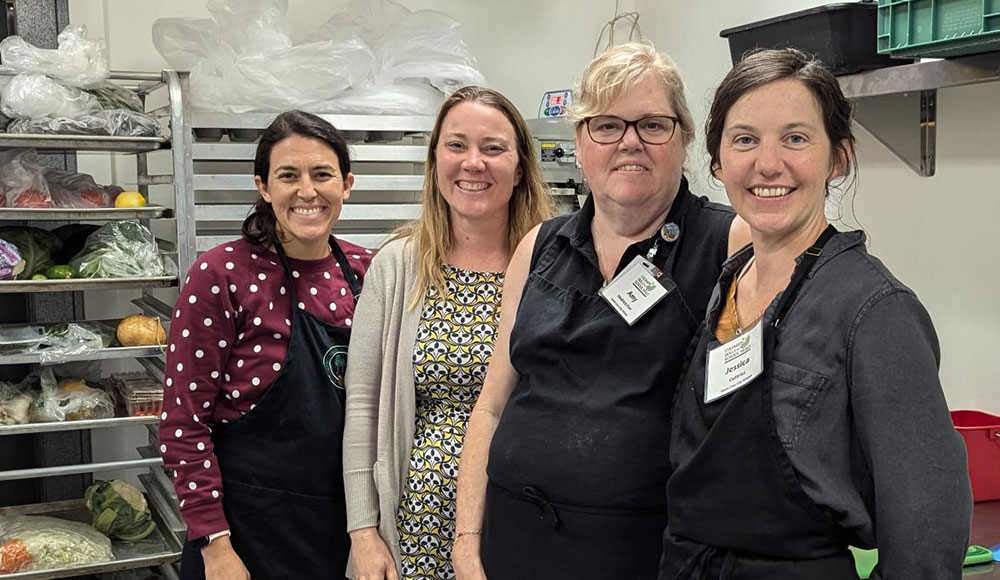Santa Cruz schools are on a mission to change the way your kids think about vegetables.
For the first time ever, five county school districts jointly participated in a culinary training program designed to present a fresh take on produce to the standard school lunch.
Farm to table came to life last week as lunch staff from Pajaro, Live Oak, San Lorenzo Valley, Soquel and Santa Cruz school districts met at Del Mar Elementary school, where, under the tutelage of a CIA-trained chef, they spent five days in an intensive culinary training bootcamp at the Live Oak District Central Kitchen.
Yes, the school cafeteria has evolved since the days when ketchup counted as a vegetable. Today’s school lunches are balanced according to federal nutrition guidelines, and in Santa Cruz most of the produce is organic. Healthy meals are made and served up by the Child Nutrition experts formerly known as lunch ladies.
Flavorful food can seem an afterthought in schools bound by a highly regulated system built on consistency, federal nutrition requirements and scalability, to name a few. Yet Santa Cruz County schools are flexing within the system by improving the way they treat the food that comes into their kitchens. And more importantly, the people who prepare it.
Directors on hand for the first-ever multidistrict training were enthused about the benefits they’d already witnessed among the participants. The combination of skill building and opportunity for connection with fellow district colleagues brought a new level of engagement to work not always recognized.
By training culinary staff in preparing new large-scale recipes, schools can offer fresher food from a network of local farming partners. The produce is high quality, and the meats are grass fed and free of hormones and antibiotics. But the big benefit to kids and parents is a school lunch staff devoted to tickling developing taste buds.
The mastermind behind this grant-funded training is Cathy Powers, MS, RD, LD, a founding partner in Culinary Nutrition Associates and CIA-trained chef turned trainer. She developed this program, eight years ago, for the state of Indiana.
She explains, “We did it in Santa Cruz twice last year and they brought us back they loved it so much. The best thing to see is how the nutrition experts transform. They increase their confidence.”
The training begins with culinary basics. “So yesterday, they were learning how to use a shelf knife, practicing different techniques,” Powers says. “Today is all about vegetable cooking. The staffers form teams, they’re assigned to a different vegetable and they do it three ways—, a steamed, a roasted and a cold. They learn there’s so much you can do with vegetable, because really the key for a healthier generation is helping our students learn to love vegetables.”
Powers continues, “Today is about creating vegetable lovers because, really, that’s what we’re missing. Kids are not eating enough fruits and vegetables. While this program is not vegetarian, it’s heavily focused on making vegetables delicious. I like to say to the class, ‘if a student’s first experience with the vegetable is negative, you might have created a vegetable hater.’
Because if they tasted the broccoli and it wasn’t seasoned, you know, they may never try broccoli again. However, if you create delicious vegetables, you might create vegetable lovers. And tomorrow we’ll do the same thing with grains. We have sorghum, we have quinoa and couscous, we have brown rice and each team will have a different grain to work with.”
Since high volume cooking is so different from single-meal cooking, even chefs with a lot of culinary experience need specialized training to manage these large-scale recipes. After this week, the nutrition experts will decide which recipes they want to bring to the cafeteria menu.
They may only adopt one or two to start with, but as Powers says “we’re not teaching them recipes, we’re teaching them techniques. So whether it’s roasted broccoli, or roasted cauliflower or roasted brussels sprouts, the technique is the same. They’re learning how to use seasoning. So, whether its cumin roasted broccoli or ranch roasted carrots, they’re learning the techniques that they can implement according to their students’ palettes.”
And how do the nutrition experts know whether the kids like the food? New recipes are announced with cards containing a QR code placed on the lunch tables in some schools, so kids can scan to access a form where they can share their opinions.
In the words of Amy Hedrick-Farr, “The combination of nutrition education and outreach allows us to bring our Life Lab grown foods into the classroom and cafeteria. Thanks to our grant funding, we’re able to combine all three very successfully.”














